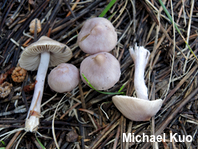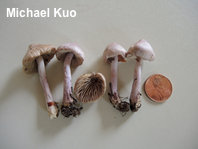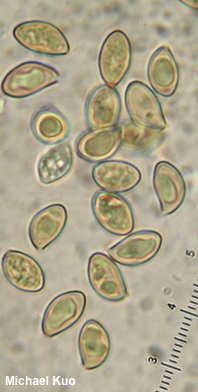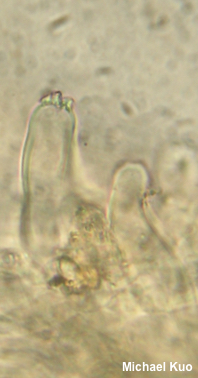| Major Groups > Gilled Mushrooms > Dark-Spored > Inocybe > Inocybe pallidicremea |

|
[Basidiomycota > Agaricales > Inocybaceae > Inocybe . . . ] Inocybe pallidicremea by Michael Kuo, 15 April 2024 One of several species recently separated in the Inocybe lilacina species group, Inocybe pallidicremea features lilac colors, a dull brown spore print, and a strong, spermatic odor. However, while the cap starts out with lilac colors, it soon begins to fade, and eventually becomes yellowish to pale brownish. The species epithet pallidicremea ("pale cream") applies to mature, faded specimens; in fact the original type collection for the species was "based on specimens in which the lilac colors must have been completely lost" (Matheny & Swenie 2018). While Inocybe lilacina also fades, its cap center typically retains purple shades throughout development; additionally its range is more southerly when compared to the northern and montane range of Inocybe pallidicremea. More difficult to separate from Inocybe pallidicremea is Inocybe sublilacina; the two species are virtually cryptic, and best separated with DNA analysis. However, according to Matheny & Swenie, pallidicremea is by far the more common of the two, and there may be a difference in spore morphology: spores of pallidicremea are flask-shaped, while spores of sublilacina are more ellipsoid. In coastal California, Inocybe ionocephala is similar, but is a bit larger and features a white stem. Description: Ecology: Mycorrhizal with conifers; growing alone, scattered, or gregariously; late summer to early winter; originally described from Nova Scotia (Grund & Stuntz 1977); distributed in northern and montane North America. The illustrated and described collection is from Colorado. Cap: 1.5–3.5 cm; conic at first, becoming broadly conic; often with a nipple-like center; dry; radially silky-fibrillose; lilac when young and fresh; fading to brownish or yellowish. Gills: Broadly to narrowly attached to the stem; close; short-gills frequent; white at first, becoming pale brown, then dull snuff brown; edges whitish; at first covered by an ephemeral, whitish cortina. Stem: 3–5 cm long; 4–6 mm thick; equal above a slightly swollen base; dry; silky or bald; whitish above and lilac below; basal mycelium whitish to yellowish. Flesh: Whitish; not changing when sliced. Odor: Spermatic. Chemical Reactions: KOH negative on cap surface. Spore Print: Dull snuff brown. Microscopic Features: Spores 9–11 x 5–6 µm; amygdaliform; smooth; brownish golden in KOH; inamyloid (brownish yellow in Melzer's). Basidia 25–28 x 5–6.5 µm; clavate; 4-sterigmate. Cheilocystidia 40–55 x 7–15 µm; widely lageniform or broadly cylindric; smooth, but developing apical crystals; walls 1–2.5 µm thick; hyaline to yellowish in KOH. Pleurocystidia similar to cheilocystidia. Pileipellis an ixocutis; elements 3–7.5 µm wide, smooth, hyaline to yellowish in KOH; clamp connections present. REFERENCES: D. W. Grund & D. E. Stuntz, 1977. (Matheny & Swenie, 2018; Matheny et al., 2020; Bandini et al., 2021.) Herb. Kuo 08061701. This site contains no information about the edibility or toxicity of mushrooms. |
© MushroomExpert.Com |
|
Cite this page as: Kuo, M. (2024, April). Inocybe pallidicremea. Retrieved from the MushroomExpert.Com Web site: http://www.mushroomexpert.com/inocybe_pallidicremea.html |



